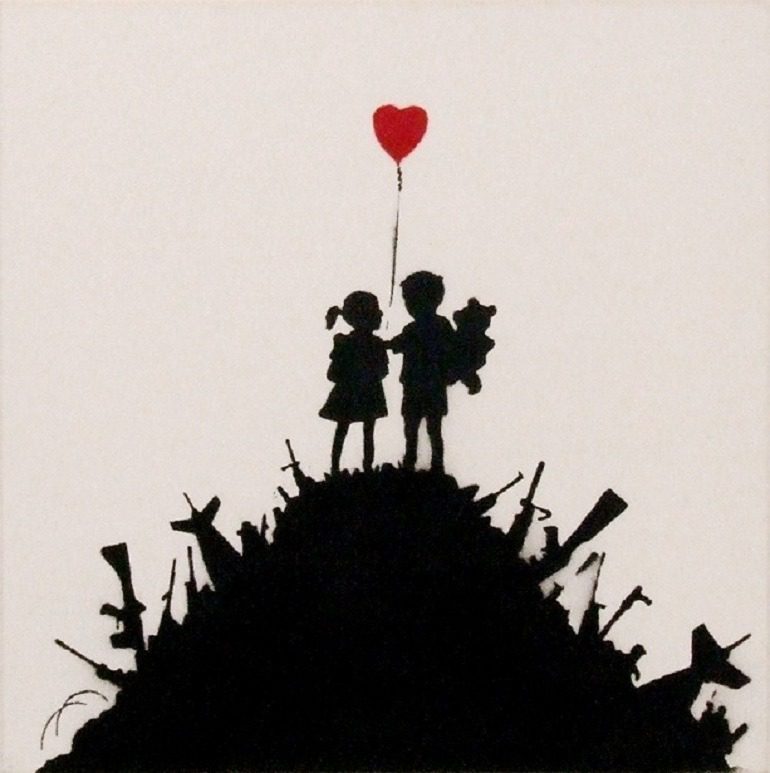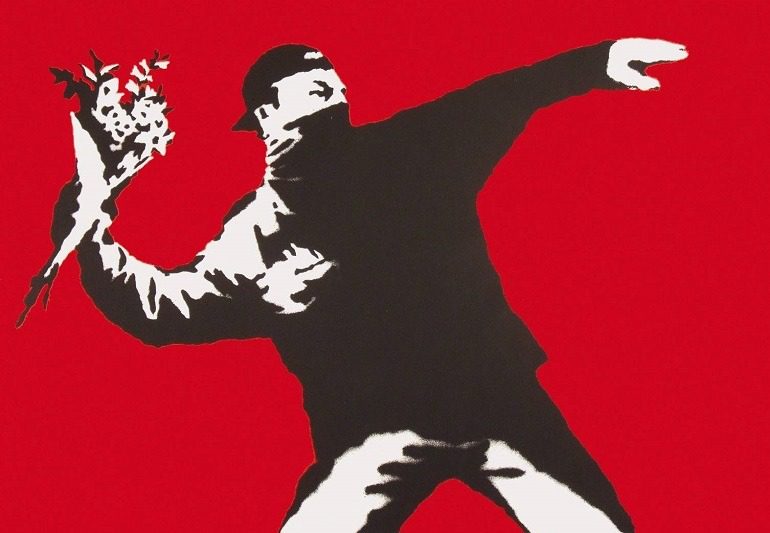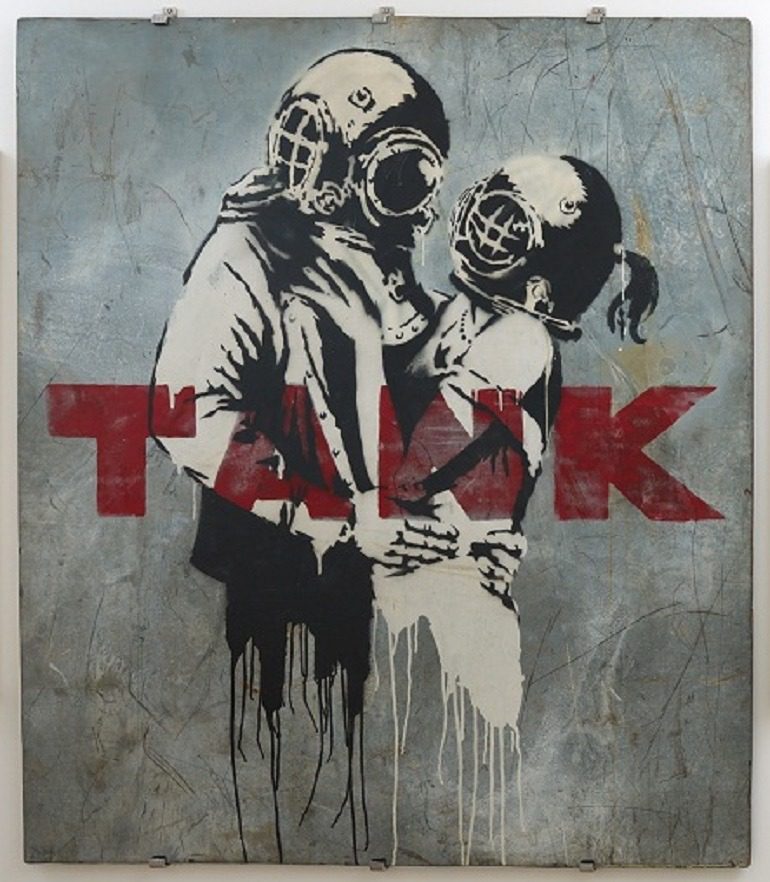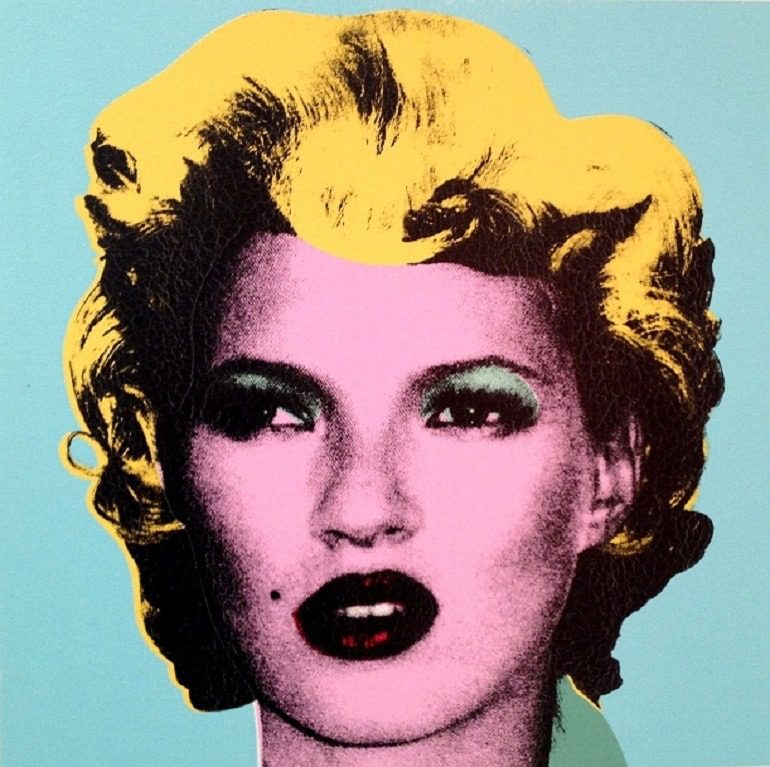ART NEWS
Jack and Jill by Banksy is one of the works on display in War, Capitalism & Liberty in Rome
REVIEW: War, Capitalism & Liberty, a riveting exhibition of artworks by Banksy proves that the artist is a megaphone for the voiceless
BY KAZAD

Banksy, Kids On Gun Hill 2003. Spraypaint on canvas. Image: Palazzo Cipolla
ROME–Who is Banksy? This question that has tormented investigators for many years again captivated the audience at the opening of the exhibition War, Capitalism & Liberty at the Palazzo Cipolla in Rome. The show is a riveting survey of Banksy’s artworks spanning several decades. It features more than 100 artworks by this elusive artist, who has captivated the art world with his very often poignant artistic statements. War, Capitalism & Liberty also includes 68 record and CD covers by the artist.
Conceived and realized by the Fondazione Terzo Pilastro-Italia e Mediterraneo, a nonprofit organization that supports projects in arts and other fields, the show includes some of Banksy’s never exhibited artworks. The artworks are from private international collectors who loaned them for the exhibition. They include sculptures, original prints, paintings, and rare objects.
ART NEWS | READ ALSO: Banksy Highlights Steve Jobs Syrian Roots in New Mural
War, Capitalism & Liberty
Although War, Capitalism & Liberty has some of Banksy’s important works, it is not an authorized retrospective. The organizers are quick to point this out: “Please note, the artist known as Banksy is not associated or involved in this museum show.”
Banksy can be described as the megaphone for the voiceless. He uses his works to address salient issues, especially those affecting ordinary people. His devotion to highlighting issues relevant to struggling people is at the core of War, Capitalism & Liberty. The title of the exhibition reflects issues Banksy has devoted his time to through the years. For more than two decades, he has used his artworks to critically examine contemporary issues of war, consumerism, politics, and oppression.
Each work in War, Capitalism & Liberty is focused on areas that have been of major concern for Banksy. Combining a blend of humor and humanity, Banksy’s artworks are reminders of inequality and disasters around the globe. An important example of his artworks is Kids On Gun Hill 2003. The spray paint on canvas painting depicts two young children-a boy and a girl- standing on a pile of weapons. In the boy’s right hand is Winnie The Poo teddy bear, while his left hand rests on the girl’s shoulder. Attached to a string in the girl’s hand is one of Banksy’s iconic red heart-shaped balloons.
Done in solid black akin to a silhouette, the boy, the girl, the teddy bear, and hill of weapons appear in sharp contrast to the gray background. The only object bearing any color is the heart-shaped red balloon flying in the sky. This heartbreaking image, in some ways, references the aftereffect of wars and the consequences on children.
Impact of Wars on Children
Beyond the devastating impact wars may have on children, the after-effects can even be catastrophic. Kids On Gun Hill is a reminder of the bombs buried during wars. Years after the wars are over, bombs continue to maim innocent children who are oblivious of the dangers under their feet. The only bright spot of this painting is the balloon. Even as it reveals the children’s innocence, it shows that love is always fleeting.
Jack and Jill (Police Kids), 2005, is another heartrending work that addresses the issues of children and the dangerous environment they live in. Based on a nursery rhyme with the same title, the painting focuses on two children, a boy and a girl, running down the hill. Wearing bulletproof vests, the children appear to be having fun as they run down the hill with smiles on their faces.
As with other works, Banksy leaves viewers with the opportunity to interpret and bring meaning to the artwork. It is uncertain if the children are running away from or towards danger. The only clarity is that there is danger in the environment where the children exist. The reference to the police and the bulletproof vests tells a disconcerting story of children who must be protected in an environment of inexplicable cruelty.
The struggle for equality, liberty, and justice in the face of oppression and economic degradation is exemplified in street protests. Love is in the Air (Flower Thrower), 2003 captures the spirit of those struggles. It portrays a man who is wearing the typical attire of rioters.
The image which is emblematic of Arab Springs, Palestinian struggles, and many others articulates the story of violence and love of war and peace. Covering the young man’s face is a bandana to protect his identity, the agonies of pepper spray, and tear gas. But this is not your usual rioter. Instead of a weapon like a brick, sling or molotov cocktail, the man has in his hand a flower bouquet. With all his vigor, he aims his flower bouquet at an invisible enemy.
Love is in the Air
Love is in the Air exudes Banksy’s devotion to contradictions. This image recalls the famous Flower Power photograph by Bernie Boston. Taken on October 21, 1967, during the National Mobilization Committee to End the War in Vietnam’s march to the Pentagon, the image bridges the relationship between war and peace. The iconic photo captures a young, long-haired Vietnam protester in a turtleneck sweater placing carnations into the barrel of a rifle of a National Guardsman. Like Boston’s image, Banksy seems to contend that instead of way, we should use our energy to spread love and peace.
The artworks in War, Capitalism & Liberty reaffirms why Banksy is one of the most celebrated street artists. There is a thoughtfulness that goes into each artwork. They are funny, provocative, and highly political. Artworks like Golf Sale, 2003, Laugh Now, 2002, and Kate, 2005 are poignant in addressing war, capitalism, and obsessive human nature.
In 2000, Banksy’s first-ever exhibition was held at the Severn Shed in the United Kingdom. Since that exhibition that brought him unprecedented attention to Banksy’s art, the artist has gone on to create even more poignant and politically charged artworks. His nine Sardonic images on the Palestinian side of the West Bank Barrie show the power of Banksy art. The artworks generated so much attention, bringing renewed focus to the plight of the Palestinians.
Capitalism and the Plight of Refugees
In 2015, Banksy generated great awareness for the plight of refugees escaping the war in Syria, Iraqi, and across Africa. At the Calais refugee camp, he created a series of murals, including The Son of a Migrant from Syria featuring late Apple finder Steve Jobs. The image of Jobs carrying a computer in one hand and a bag in the other was very compelling in countering anti-refugee and anti-immigrant sentiments. This was followed by his Dismaland Theme Pack in Weston-Super-Mare in Bristol. The alternative seafront theme park invited guests to experience attractions billed as “an escape from mindless escapism.”
Banksy: A Phenomenon in the Street Art World
Banksy is a phenomenon in the street art world. His anonymity and mysterious ways have captivated international audiences since the late 1990s. His versatility, above all else, has giving him credence above his peers. From painting on canvas to screen-prints, sculpture, large scale installations, and even occasional livestock, Banksy has moved his creations from the fringe to the center.
Who is Banksy
Speculated to have been born in Bristol in 1974, Banksy’s distinctive style developed out of necessity. Inspired by the Bristol Underground Scene, the need to quickly create large-scale works engendered his use of stencil and graffiti writing. After his first solo exhibition in Bristol in 2000, Banksy’s art has also been shown in several other exhibitions, including at the Los Angeles’ 33 1/3 Gallery. In 2003, He was commissioned to design the cover of Blur’s Think Tank. The result is the image of a man and a woman in a tight embrace. On their heads are diver’s helmets, preventing them from kissing.
Banksy’s exhibition at the Bristol Museum and Art Gallery are epochal in the true sense of the word. The 2009 exhibition attracted more than 300,000 art lovers. There was also a long queue of art lovers spiraling down the road. It was like an exhibition of art masters was taking place in the gallery. But this is just one of the achievements of this celebrated urban artist. He has experimented with films, archiving an Oscar nomination for his document Exit Through The Gift Shop.
Banksy’s official residency in New York in 2013 generated unprecedented attention and put him at crosshair with the authority. He was chased by New York Police that wanted to remove his artworks and fans that cherished the works of this notorious graffiti artist. Using social media, especially twitter, he gave the geographic location of his new artwork, sending fans on an Indiana Jones-like expedition across New York. Titled Better Out Than In, the residency also included the setting up of a street stall where he sold some of his original canvasses for $60 to tourists. Many walked by unknown that they were walking past valuable works of art. The few that bought some of the artworks sold them for thousands of dollars at the auction.
War, Capitalism & Liberty was curated by Acoris Andipa, director of Andipa Gallery, Stefano Antnelli, and Francesca Mezzano, founders of 999 Contemporary. Touted as the biggest ever exhibition of artworks by Banksy, this show is significant as it brings into focus the different aspects of Banksy’s artistic career. From his monkey series to images of heart-shaped balloons, and children, there is consistency in his quest to address the plight of those suffering by giving voice to the voiceless.
Banksy’s artworks are issues-oriented and his focus has always been on contentious matters. From the sufferings of the Palestinians to the plight of refugees, he has remained committed to bringing attention to issues affecting ordinary people around the globe.

Banksy, Love is in the Air (Flower Thrower) , 2003. Screenprint on paper 50 x 70 cm. Image: Palazzo Cipolla

Banksy, Golf Sale 2003. Screenprint on paper 35 x 50 cm. Image: Palazzo Cipolla

Banksy, Think Tank 2003. Stencil 155 x 134 cm. Image: Palazzo Cipolla

Banksy, Flags 2006, Screen print. 50 x 70 cm. Image: Palazzo Cipolla

Banksy, Kate (Original Colourway), 2005. Screenprint on paper 70 x 70 cm. Image: Palazzo Cipolla
Join the art conversation: Share your thoughts and comments. Facebook– Twitter–Google+
